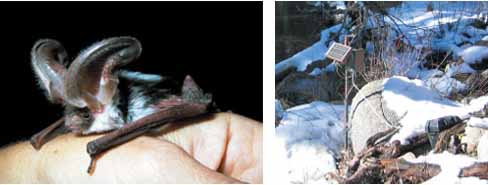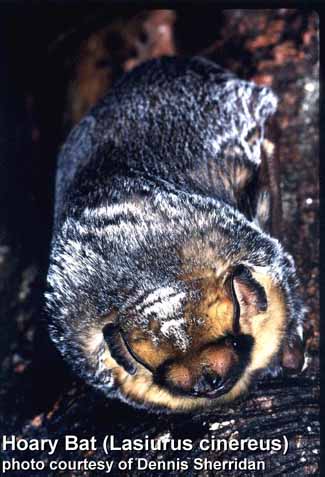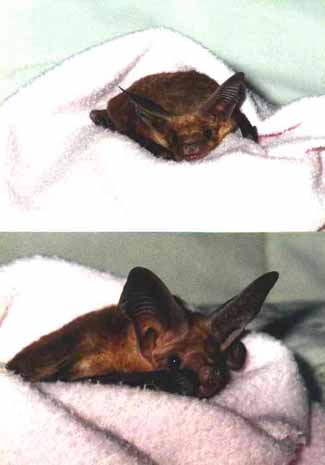Using bat assemblages as a measure of ecosystem health
By Leslie Chow, Elizabeth Pierson, and William E. Rainey
As predators that rely almost exclusively on insects, bats may provide a reliable measure of ecosystem function.
 |
| Left: spotted bat (Euderma
maculatum, juvenile shown). Solar powered Anabat acoustic detection system at right. Copyright William E. Rainey (2) |
Comprising the second largest order of mammals in North America, bats trail only rodents in number of species. The NPSpecies database has records for 77 species and subspecies of bats in 141 units of the National Park System, with an average of 5 species per unit. Seventeen bat species occur in Yosemite National Park. The park is the site of a three-year study of bat activity and overwintering habits. The study tested solar-powered Anabat acoustic detection systems to monitor winter bat activity at 15 sites in Yosemite National Park, including this one along the South Fork of the Merced River.
 |
| Photo: California Bat Conservation Fund |
IN 2003 THE U.S. GEOLOGICAL SURVEY and
University of California–Berkeley
began a three-year study to investigate patterns of bat distribution and
activity in response to aquatic insect emergence and abundance in Yosemite
National Park, California. Called “Project Bats and Rivers,” the
study is funded by the Yosemite Fund, a private, nonprofit partner of the
park. Using a combination of acoustic sampling and mist (fine mesh) netting,
investigators learned that the number of bat species declines as elevation
increases; the number of species with reproductive populations also declines
with elevation. Preliminary analyses reveal considerable night-to-night variation
in activity levels at most sites. Bat activity in the summer and autumn generally
correlates with ambient temperature, with the greatest activity occurring
on the warmest nights. In 2004 the team made the unexpected discovery that,
though activity is low on the coldest nights, insect emergence and foraging
continue at temperatures near freezing. Although the Bats and Rivers project
started as an investigation of bat distribution and activity, two years of
fieldwork suggested that the techniques being used were also applicable to
monitoring ecosystem function by detecting changes in bat assemblages (groups
of bat species inhabiting specific areas).
Until recently, bats have been hard to study because they are nocturnal and
capturing them in mist nets is challenging. Acoustic detection now provides
a reliable technique for recording and identifying each species based on its
unique echolocation calls. During the 2004 field season the team continued
to modify and improve the reliability of the Anabat acoustic detection system
so that it can be used for long-term monitoring. Falling prices and lower power
requirements for data storage devices have allowed investigators to deploy
equipment that can operate without intervention for up to three months. These
devices, which turn themselves on at dusk and off at dawn, store bat calls
on small memory cards. The solar-powered systems have allowed researchers to
sample simultaneously at multiple locations for extended periods with minimal
labor. The system automatically identifies the species and records its abundance
for a given night.
 |
| Cuuuute:
Pallid Bat (Antrozous pallidus) Photo: California Bat Conservation Fund |
The team tested the efficacy of using this equipment in July 2003 by deploying
15 detectors simultaneously at selected elevations for six to eight nights.
The detector in Yosemite Valley, when downloaded in late January 2004, revealed
highly unexpected results: very high levels of bat activity (rivaling levels
in summer) over the river, even on nights when the temperature dropped well
below freezing. To place this finding in context, there is almost no information
regarding where California bats winter. Although very large aggregations hibernate
in caves in the eastern and midwestern United States, very little is known
about winter behavior or overwintering sites for most western species. The
intense bat activity, involving at least three species, suggests that Yosemite
Valley, with its combination of granite cliffs and nearby river, may serve
as a significant winter refugium for bats.
As predators that rely almost exclusively on insects, bats may provide a
reliable measure of ecosystem function. Changes in the composition of bat
species in a particular location may reflect ecosystem changes that require
more intensive study. Using arrays of 8 to 10 acoustic detectors spread among
a variety of habitats enables investigators to “capture” the
widest diversity of bat species, increasing the chances of detecting those
that are rare or habitat-specific.
The Sierra Monitoring Network is currently inventorying bats in three
parks. In Sequoia National Park, two Anabat acoustic detectors are monitoring
bat activity over the 2004–2005 winter. A remaining challenge for the Anabat
system is developing filters that will fully automate the identification of
bats from their calls. Though the Anabat acoustic detection system recognizes
the sonogram of the calls of many species, some species still require visual
examination of call sequences. The team is also working on designing a statistically
valid sampling protocol for detecting real changes in bat assemblages. When
the protocol is fully developed, assemblages of bat species could be selected
as a “vital sign,” an indicator of ecosystem conditions for
monitoring networks where bats abound.
les_chow@usgs.gov
Wildlife Biologist, U.S. Geological Survey Western Ecological Research
Center, Yosemite Field Station, California
edpierson@aol.com
Consulting Biologist, Berkeley, California
rainey@socrates.berkeley.edu
Associate Specialist, Department of Integrative Biology, University of
California–Berkeley
Further Reading
California Bat Conservation Fund Photos of bats as well as what to do with a bat in your house or where to take an injured bat. Offers educational outreach.
Watchable Wildlife:
Bats California Department of Fish and Game
California Bats
Our Founder Questions? Go to About Our New Site |
Masthead
Photo from: |